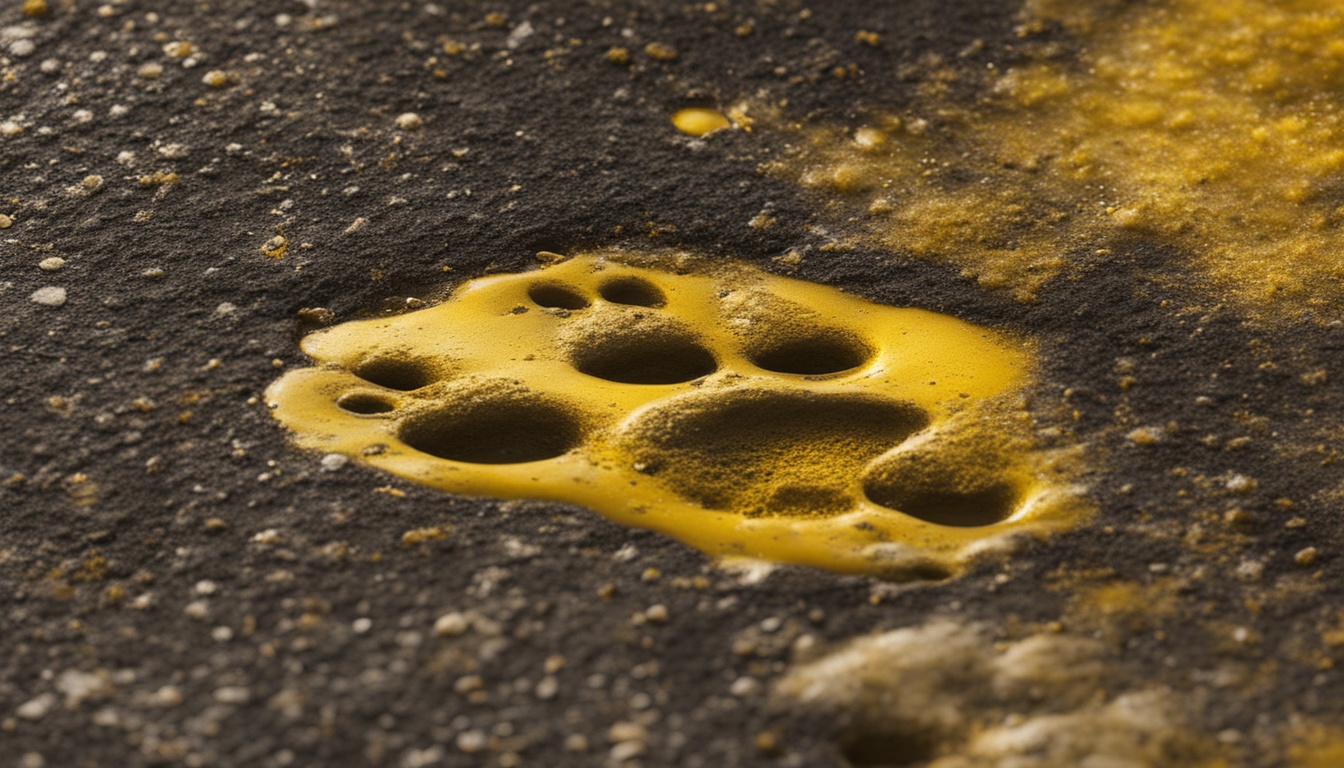Have you noticed your dog vomit in yellow? It may seem odd, but it tells a lot about their health. Dogs throw up for many reasons. Sometimes, it could be simple, like an empty stomach.
The yellow vomit, known as “hunger pukes,” is common when their stomach is empty. This is not usually serious. But, if it happens a lot, you should pay more attention. Changes in color and texture could hint at bigger health problems.
These signs might point to eating something bad or having a health issue. If your dog throws up a lot or the vomit doesn’t look right, ask a vet for help1.
Key Takeaways
- Yellow vomit often indicates an empty stomach due to bile secretions, known as “hunger pukes”1.
- Frequent yellow vomiting can signal underlying dietary issues or gastrointestinal diseases.
- Recognizing the vomit’s color and consistency helps in determining the severity of your dog’s condition.
- Immediate veterinary attention is required if vomiting is persistent or contains blood1.
- Monitoring your dog’s diet and feeding frequency can help prevent occurrences of yellow vomit.
What Causes Yellow Vomit in Dogs?
Yellow vomit in dogs can happen for many reasons. Knowing these reasons helps keep your dog healthy. It can also make sickness easier to prevent or treat.
Dietary Indiscretion
Eating things they shouldn’t is a top cause. This includes trash and bad table scraps. Sometimes, changing food quickly can also make a dog throw up yellow stuff. Eggs2, peanuts2, and other foods can upset their stomachs too.
Regurgitation vs Vomit
Regurgitation and vomiting are different. Regurgitation is easy and undigested food comes up. Vomiting is more active, with the stomach pushing its contents out. You shouldn’t see a dog vomit a lot. And, did you know, most dogs who eat grass don’t usually get sick?3
Hunger Pukes
Puking because they’re hungry often results in yellow vomit. This happens more in the morning or if the dog hasn’t eaten for a while. It’s common in puppies because they need to eat often. Feeding little but often or giving snacks before bed can stop hunger pukes. Without food, bile can hurt the stomach lining and cause yellow puke.1
Understanding the Color of Dog Vomit
Dog Vomit Color Meanings can tell us a lot about a dog’s health. It’s vital to notice different vomit colors. This helps tell if your dog is okay.
Yellow and Green Vomit
Yellow and green vomit often means there’s bile in it. Dogs throw up yellow or green stomach acid when they’re empty. This happens a lot if they eat grass or something that upsets their stomachs3. Sometimes, yellow bile vomit shows up when their stomach is empty.
Significance of Bile
Bile is a type of stomach juice. It makes the vomit a yellow-green color if the dog hasn’t eaten. This tells us something about how their stomach is working3. If a dog throws up a lot of yellow or green, it might point to stomach problems. This is called bilious vomiting syndrome4.
In summary, knowing about Dog Vomit Color Meanings is important. If you see yellow bile vomit in dogs, you should pay attention. It could mean they need to see a vet.
How to Differentiate Vomiting from Regurgitation
It’s key to know the difference between dog vomiting and regurgitation. Sometimes it can be tough for pet owners to tell them apart. But understanding can help give the right care and on time. Regurgitation is when a dog throws up undigested food or liquid and doesn’t reach the stomach. This usually happens fast after eating or drinking with no warning.
On the other hand, vomiting means the dog’s stomach is squeezing hard and forcefully throwing up. If a dog throws up multiple times, there might be a bigger problem. Dr. Carol Osborne says to pay close attention. Even one episode of vomiting is okay, but if it happens more, you should talk to the vet3. Watch out for many vomiting times; this needs fast vet help3.
Not all vomiting is a huge concern if it happens once in a while. But, lots of regurgitation might mean serious throat problems. This issue needs deep vet check-ups to find the reason.
A New York study says 79% of local dogs can get sick from parasites. This is if they eat feces or sniff poop on the sidewalk3. Such actions can lead to both vomiting and regurgitation. So, it’s important to stop these behaviors and treat any dog digestive problems right away. Also, yellow vomit is often seen in puppies and means their stomach is empty because of bile1.
So, knowing the difference between regurgitation and vomiting is crucial for good pet care. If these problems happen often or bad, see your vet. It’s about keeping your pet healthy.
Common Symptoms Accompanying Yellow Vomit in Dogs
Seeing your dog vomit yellow can spark worry in pet owners. This often happens when a dog vomits without anything in their stomach or when something is bothering them2. The signs linked with this can vary from minor to serious. Some may need a vet’s attention quickly.
Little symptoms, like a dog throwing up when hungry, are usually no cause for alarm. This might happen in the night or early morning. In these cases, feeding them more often but with smaller portions could help. Yet, if the vomit is bloody, or your dog seems very tired, has diarrhea, or doesn’t want to eat, something more serious could be happening. It might be a stomach problem, an issue with the liver, or even poison25.
It’s very important to keep an eye. If the yellow vomit comes with paling gums, a high temperature, or keeps happening, this could point to serious health issues. Examples are pancreatitis, bloat, or other stomach upsets6. Watching your dog closely after they vomit yellow can help you see if they need medical care.
Look out for signs like your dog being really thirsty, seeming in pain, or having a hard belly before they vomit yellow. Catching these symptoms early and dealing with the yellow vomit correctly can stop worse health problems.
| Symptom | Possible Indication |
|---|---|
| Occasional Yellow Vomit | Hunger pukes; usually benign2 |
| Frequent Vomiting | Gastrointestinal issues, liver disease, bloat (GDV)56 |
| Presence of Blood | Serious internal problems; requires veterinary attention5 |
| Lethargy and Appetite Loss | Possible indication of toxins or infections6 |
| Other Symptoms (Diarrhea, Dehydration) | Possible pancreatitis or other severe health conditions6 |
When to Seek Veterinary Attention
It’s key to know when yellow vomit in dogs means trouble. If a dog keeps throwing up or you see blood in the vomit, it’s time to call the vet. These signs are serious and could point to big health problems.
Persistent Vomiting
If your dog tosses their cookies more than twice in a day, it’s a red flag. This might be more than just a tummy ache from eating something wrong. In fact, dietary issues cause about 55 out of 100 cases of dog barfing3. If the spews persist for weeks, head to the vet quickly. Prolonged vomiting can dehydrate your pet and lead to further health troubles3.
Blood in Vomit
Seeing blood in vomit, whether it’s bright or dark like coffee, is very serious. It could mean the dog has hurt their insides, has an ulcer, or ate something toxic1. If their vomit is red or dark, it might be from eating something poisonous, needing urgent vet care3. A term for this is hematemesis, which shows there’s a problem in the stomach or intestine1.
Prevention and Care Tips for Dog Vomiting
To help your dog stop vomiting, you should change what they eat. This means slowly switching to a new food over 10-14 days. It lessens tummy problems and makes sure the food is right for them. This is important, especially if your dog throws up bile when their stomach is empty21.
Dietary Adjustments
Sometimes, a dog might puke if their diet changes quickly. To avoid this, start a new food slowly over 10-14 days. This helps keep their stomach settled and checks for any food they might be sensitive to1.
Feeding Frequency
It’s key to feed your dog regularly, especially puppies. Small and frequent meals can stop vomiting from an empty stomach or BVS7. BVS happens when bile gets in the stomach because it’s empty for too long. This leads to throwing up yellow foam. Feeding snacks before bed can also be helpful7.
Probiotics and Digestive Enzymes
Adding certain supplements to your dog’s diet can help a lot. For example, herbs like Meadowsweet, Marshmallow Root, and Licorice calm the stomach2. Probiotics and enzymes keep the gut healthy and stop too much acid, which can swell if your dog eats dry food too quickly. If your dog vomits, give them water slowly to keep them from getting dehydrated7.
Here’s a table that shows the main tips.
| Prevention and Care Tips | Details |
|---|---|
| Dietary Adjustments | Gradually switch food over 10-14 days to stop stomach issues. |
| Feeding Frequency | Eat small meals often to avoid vomiting from an empty stomach or BVS. |
| Probiotics and Digestive Enzymes | Help the stomach work well and avoid too much acid. |
| Hydration | Give water after throwing up so they don’t get dehydrated. |
Treatments for Yellow Vomit in Dogs
Yellow vomit in dogs needs the right treatment. First, figure out why it’s happening. If it’s just an upset stomach, changing the dog’s food or feeding them more often might help12.
If the vomit is yellow and foamy, it could be the dog’s stomach is empty. In this case, giving them a little food before bed can stop it1. But, if the vomit is yellow or bloody, it’s time to see the vet. This could mean something more serious is going on inside the dog, like an illness or eating something bad13.
Addition, giving dogs probiotics can be good for their stomachs. Probiotics make sure their gut stays healthy, helping with digestive problems2.
Also, natural things like licorice and chamomile might calm the dog’s upset stomach. They could be a good add-on to their regular care2.
Decoding Yellow Vomit in Dogs
Finding out why your dog has yellow vomit is really important. It helps catch any health problems early and make sure they get the right care. This problem can happen because of many things, from not too serious to very important health conditions.
Possible Underlying Health Issues
Seeing yellow vomit may mean the dog’s stomach is empty and just has bile. But, it could also be a sign of bigger problems1. If your dog throws up yellow often, it might signal health issues like liver, kidney, or pancreatic problems. It could also be from inflammatory bowel disease or acid reflux3. Infections, parasites, and health issues like pancreatitis and kidney failure can cause vomiting too3.
Role of Stomach Acids
Yellow bile in vomit shows us a lot about a dog’s digestion. Stomach acids and bile help break down food. But, too much might mean there’s a problem in how the dog digests1. For example, if your dog vomits yellow in the morning, it could be bilious vomiting syndrome. This happens when bile builds up and the stomach is empty, making the dog feel queasy3. Knowing about these issues helps with finding the right treatment, especially for puppies that vomit yellow.
Keep a close eye on your dog and learn what yellow vomit could mean. It’s not always serious, but sometimes it can point to big health conditions. Spotting these signs early and getting the right care are very important for your dog’s health.
Conclusion
Knowing about yellow vomit in dogs really helps see how they’re doing. The color, how often they vomit, and any other symptoms tell us a lot. If a dog throws up yellow, it might be because their stomach is empty, or they changed their diet, or something is bothering their stomach. This often worries dog owners2.
Yellow vomiting can also happen if a dog ate something they shouldn’t. Or, it might be a sign of a more serious health issue like pancreatitis. In these cases, the dog needs to see a vet2.
To help, dog owners should pay attention to what their dog eats. It’s good to slowly introduce new foods and keep their meals on a schedule. Some herbs like Meadowsweet, Marshmallow Root, Chamomile, and Licorice can be used for mild cases. But, for serious or ongoing issues, or suspected poisoning, a vet visit is necessary8.
Being informed helps dog owners keep their pets healthy. Knowing when to change the dog’s diet or get medical help is important. With this info, dog owners can help their pets feel better if they throw up yellow. This makes for a happier home for both the dogs and their owners.
FAQ
What are the most common causes of yellow vomit in dogs?
Dogs can vomit yellow if they eat trash or harmful foods. They might also throw up due to an empty stomach. Eating harmful objects or having health issues can cause it too.
How can I differentiate between regurgitation and vomiting in my dog?
Regurgitation is when food comes up without effort. Vomiting involves stomach heaving. If regurgitation happens a lot, your dog needs to see the vet.
What does yellow or green vomit indicate?
Yellow or green vomit means there is bile present. This happens with an empty stomach or if the digestive system is upset. It could also be from a condition called bilious vomiting syndrome (BVS).
How can I help my dog if they are experiencing “hunger pukes”?
Feed your dog more often or give them a snack before bed. This prevents their stomach from being empty. Thus, it lowers the chance of vomiting bile.
What should I look for in the color of my dog’s vomit?
The vomit color gives clues. Yellow and green show there is bile. If you see blood, call the vet right away as this can mean serious problems.
What are the common symptoms accompanying yellow vomit in dogs?
Symptoms vary but can be mild or severe. They range from simple hunger pukes to signs like blood, tiredness, diarrhea, or not eating. After your dog vomits, watch their behavior and any new symptoms carefully.
When should I seek veterinary attention for my dog’s vomiting?
See the vet if your dog vomits many times or if there is blood. This could signal a serious health issue that needs care soon.
What preventive measures can I take to manage dog vomiting?
To reduce vomiting, change their diet, adjust feeding times, and add gut-friendly supplements. Making diet changes slowly over a couple weeks can prevent stomach upsets.
What treatments are available for yellow vomit in dogs?
How to treat yellow vomit depends on what causes it. Simple fixes include food changes. But if there’s bile or blood, your dog needs a vet to find the issue.
What underlying health issues could yellow vomit in dogs indicate?
Yellow vomit could signal several health issues. These include problems with the liver, kidneys, or pancreas. It could also show infections, inflammations, or issues with the gut, needing a vet’s checkup.



